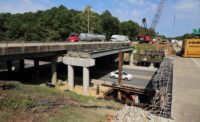State departments of transportation are receiving an additional $7.9 billion for highway and bridge projects, thanks to the Federal Highway Administration’s latest annual August redistribution of funds that FHWA has not yet obligated to certain nationwide programs.
In an Aug. 31 memo from administrator Shailen Bhatt, FHWA notified state DOTs that the total to be redistributed for fiscal year 2023 is $7.9 billion, the largest amount ever, and a 27% increase over 2022’s $6.2 billion.
The redistributed funds were in great demand. This year, all 50 states and the District of Columbia received shares of the $7.9 billion.
Susan Howard, American Association of State Highway and Transportation Officials director of policy and government relations, says, “There’s definitely no shortage of needs."
States must move quickly to obligate this “bonus” funding. FHWA said they must commit the funding to projects by Sept. 26.
The redistributed aid is in the form of obligation limitation, the cap on how much highway funding a state can commit to projects in a fiscal year. The nationwide "ob limit" total is set in annual appropriation bills.
Howard said in an interview that even with the tight deadline, states “will be able to fully absorb the August redistribution this year." She adds, "There won’t be any obligation limitation left on the table."
Howard says that the redistributed funding has grown because of uncommitted balances in FHWA funds that are not allocated to states based on formulas.
The largest source in recent years has been the Transportation Infrastructure Finance and Innovation Act, or TIFIA. the program, created in 1991.
It provides low-interest federal loans and other credit assistance at attractive terms to highway, transit and other types of transportation projects.
U.S. DOT continues to approve TIFIA applications, completing nine credit agreements so far in fiscal 2023. It completed 12 in 2022.
Howard says another contributor to the increased redistribution total is the Infrastructure for Rebuilding America or, INFRA, grant program. INFRA, launched in 2015, is a competitive discretionary grant program that focuses on highway, multimodal freight and rail projects.
U.S. DOT selects the winning projects from among applications from states or other entities.
Moreover, the increase in non-formula program funding under the 2021 Infrastructure Investment and Jobs Act (IIJA) may lead to higher amounts of uncommitted obligation limit going forward.
As the size of the August redistribution pie grows, Howard says, "I think states' ability and capacity to continue to absorb it may not last forever."
She says AASHTO is working with FHWA and Congress "to figure out if there's ways that we can modernize August redistribution to address these slow-spending, non-formula programs."
Largest State Allocations (in millions of dollars)
| 1 | California | 717.9 |
| 2 | Texas | 465.0 |
| 3 | Pennsylvania | 460.5 |
| 4 | Florida (tie) | 425.0 |
| 4 | New Jersey (tie) | 425.0 |
| 6 | New York | 313.0 |
To use the redistributed aid, state DOTs also must have sufficient matching federal highway contract authority, another type of funding.
Howard describes contract authority as essentially the permission to spend amounts provided through federal transportation authorization statutes, such as the IIJA.





Post a comment to this article
Report Abusive Comment